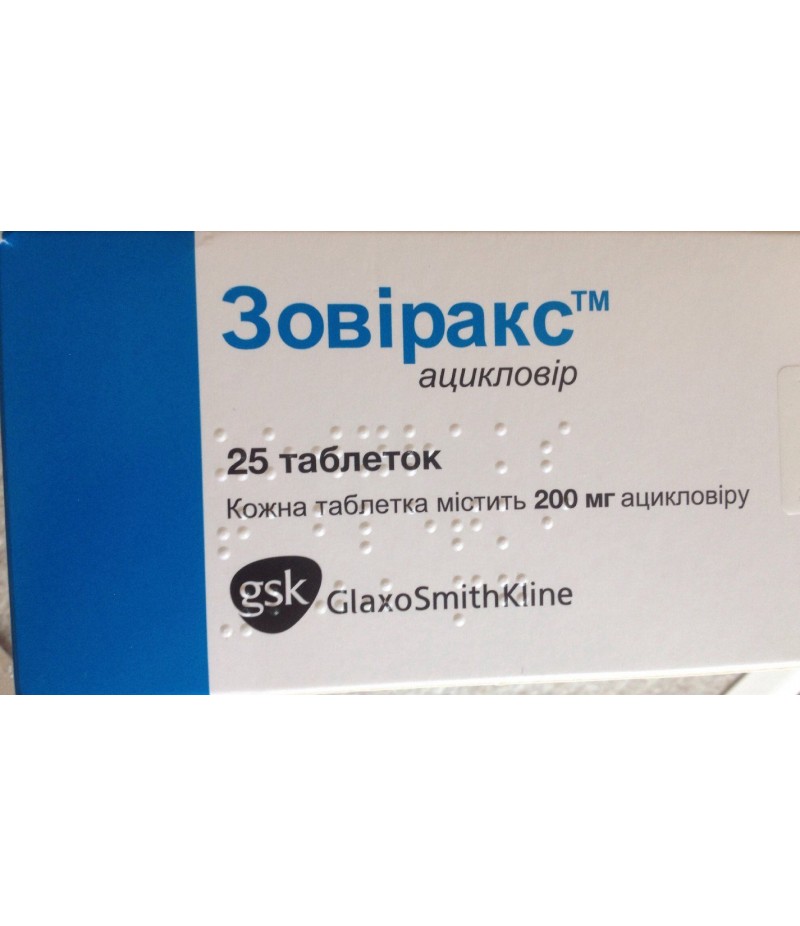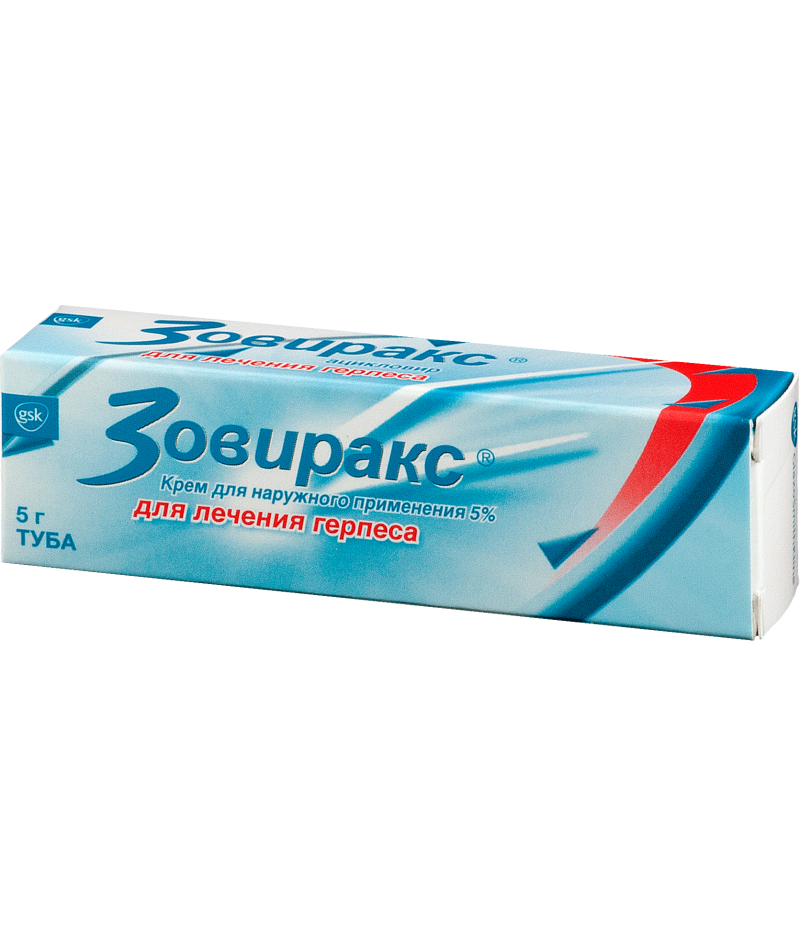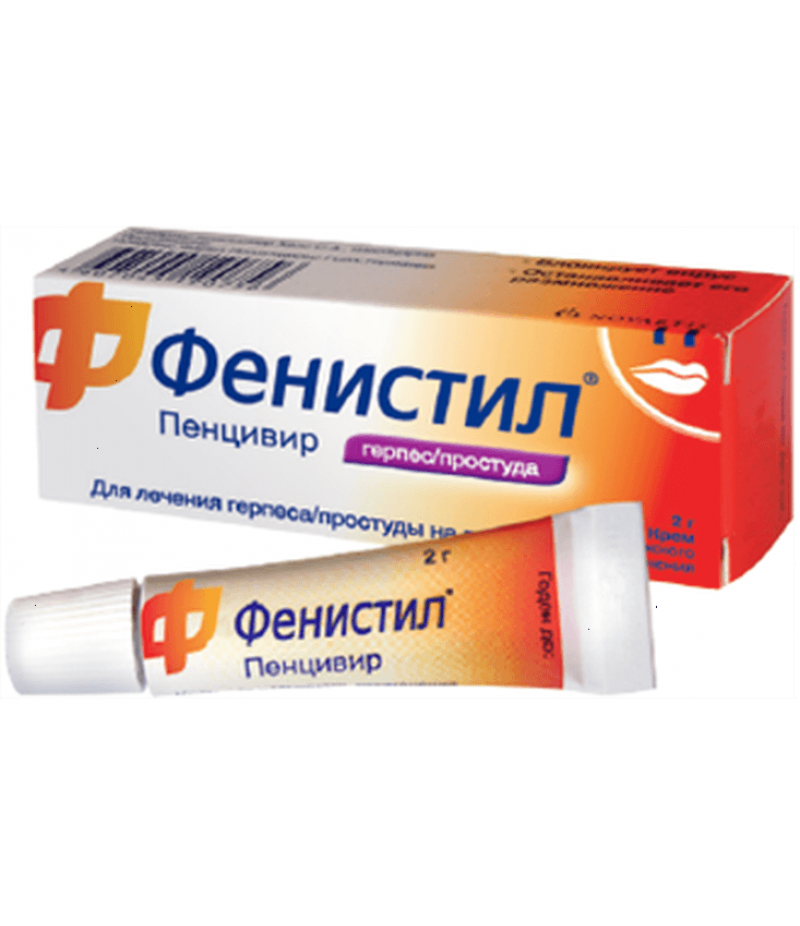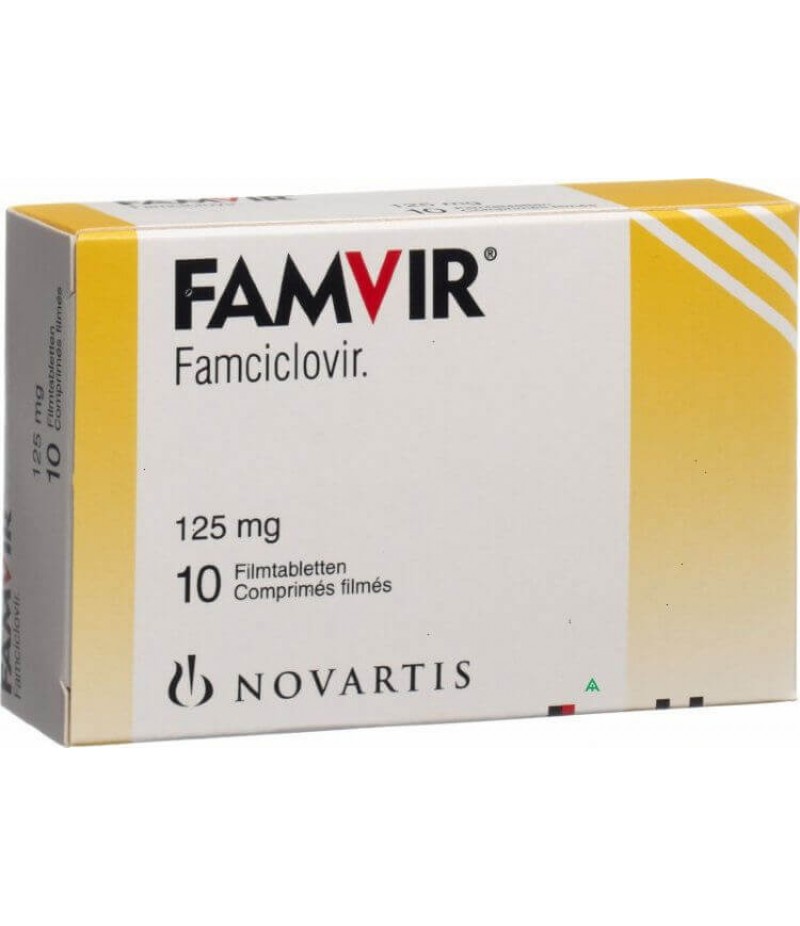Zovirax 200mg #25
- $27.27
- 3 or more $25.56
- Availability:In Stock
Zovirax instructionYou can buy Zovirax onlineForm release, composition and bundleTablets are white, round, biconcave, with the inscription "GXCL3" on one side. 1 tab. Acyclovir 200 mg. Excipients: lactose monohydrate, sodium starc..
Tags: tabs
Zovirax instruction
You can buy Zovirax online
Form release, composition and bundle
Tablets are white, round, biconcave, with the inscription "GXCL3" on one side. 1 tab. Acyclovir 200 mg. Excipients: lactose monohydrate, sodium starch glycolate, povidone K30, magnesium stearate, microcrystalline cellulose.
Clinico-pharmacological group: Antiviral product.
pharmachologic effect
An antiviral product, a synthetic analogue of the purine nucleoside, which has the ability to inhibit the in vitro and in vivo replication of Herpes simplex type 1 and 2 viruses, the Varicella zoster virus, the Epstein-Barr virus (EBV) and the CMV cytomegalovirus (CMV). In cell culture, acyclovir has the most pronounced antiviral activity against Herpes simplex type 1, followed in order of decreasing activity: Herpes simplex type 2, Varicella zoster, EBV and CMV. The effect of acyclovir on viruses is highly selective. Acyclovir is not a substrate for the enzyme thymidine kinase of uninfected cells, so it is low-toxic for mammalian cells.
Thymidine kinase cells infected with Herpes simplex type 1 and 2 viruses, Varicella zoster, EBV and CMV, converts acyclovir to acyclovir monophosphate, an analogue of the nucleoside, which subsequently is subsequently converted to diphosphate and triphosphate by cellular enzymes. Inclusion of acyclovir triphosphate in a chain of viral DNA and in the subsequent chain termination block further replication of the viral DNA. In patients with severe immunodeficiency, prolonged or repeated courses of therapy with acyclovir can lead to the formation of resistant strains, and therefore further treatment with acyclovir may not be effective.
The majority of isolated strains with a reduced susceptibility to acyclovir showed a relatively low content of viral thymidine kinase, a disruption in the structure of viral thymidine kinase or DNA polymerase. The effect of acyclovir on strains of the Herpes simplex virus in vitro can also lead to the formation of less sensitive strains. There was no correlation between the susceptibility of strains of the Herpes simplex virus to acyclovir in vitro and the clinical efficacy of the product.
Pharmacokinetics
Suction
When administered orally, acyclovir is only partially absorbed from the intestine. When taking 200 mg of acyclovir after 4 hours, the average CSSmax in the plasma was 3.1 μmol (0.7 μg / ml), and the average CSSmin was 1.8 μmol (0.4 μg / ml). When taking 400 mg and 800 mg of acyclovir after 4 hours, CSSmax was 5.3 μmol (1.2 μg / ml) and 8 μmol (1.8 μg / ml) respectively, and the mean CSSmin was 2.7 μmol (0.6 μg / ml) and 4 μmol (0.9 μg / ml), respectively.
Distribution
The concentration of acyclovir in the cerebrospinal fluid is approximately 50% of its plasma concentration. Acyclovir, in an unrelated degree (9-33%), binds to blood plasma proteins.
Metabolism and excretion
The main metabolite of acyclovir is 9-carboxymethoxy-methylguanine, which in urine accounts for 10-15% of the administered dose of the product. T1 / 2 is 2.5-3.3 hours. Most of the product is excreted by the kidneys unchanged.
Renal clearance of acyclovir significantly exceeds the creatinine clearance, which indicates the elimination of acyclovir not only by glomerular filtration, but also by tubular secretion. In the administration of acyclovir after 1 h after administration, 1 g of probenecid T1 / 2 and AUC increased by 18 and 40%, respectively.
Pharmacokinetics in special clinical cases
In patients with chronic renal insufficiency T1 / 2, acyclovir was approximately 19.5 h; when conducting hemodialysis, 5.7 hours, respectively, and the concentration of acyclovir in the plasma decreased by approximately 60%. In elderly people, the clearance of acyclovir decreases with age, in parallel with a decrease in creatinine clearance, but T1 / 2 acyclovir varies slightly.
With simultaneous administration of acyclovir and zidovudine to HIV-infected patients, the pharmacokinetic characteristics of both products remained virtually unchanged.
Indications
treatment of infections of the skin and mucous membranes caused by the Herpes simplex virus type 1 and 2, including primary and recurrent genital herpes;
prevention of recurrence of infections caused by the Herpes simplex virus type 1 and 2, in patients with normal immune status;
prevention of infections caused by the Herpes simplex virus type 1 and 2, in patients with immunodeficiency;
treatment of infections caused by the virus Varicella zoster (varicella and herpes zoster);
treatment of patients with severe immunodeficiency, mainly with HIV infection (CD4 + cell count <200 / μL), with early clinical manifestations of HIV infection and with a developed clinical picture of AIDS) who underwent bone marrow transplantation.
Dosing regimen
Adults for the treatment of infections caused by the Herpes simplex virus type 1 and 2, the recommended dose of Zovirax is 200 mg 5 times a day after 4 hours (except during the night sleep). Usually the course of treatment is 5 days, but can be prolonged with severe primary infections.
If the immunodeficiency is expressed (for example, after a bone marrow transplantation) or if there is a violation of absorption from the intestine, the dose of Zovirax for oral administration may be increased to 400 mg 5 times a day. Treatment should be started as soon as possible after the onset of infection; when relapses, the product is recommended to be prescribed already in the prodromal period or with the appearance of the first elements of the rash.
To prevent recurrence of infections caused by the Herpes simplex virus type 1 and 2, the recommended dosage of Zovirax is 200 mg 4 times / day (in 6 hours) in patients with normal immune status. A more convenient therapy scheme is suitable for many patients: 400 mg 2 times / day (after 12 hours). In some cases, lower doses of Zovirax are effective: 200 mg 3 times / day (8 hours) or 2 times / day (after 12 hours).
Treatment with Zovirax should be periodically interrupted for 6-12 months to identify possible changes in the course of the disease. To prevent the occurrence of infections caused by the Herpes simplex virus type 1 and 2, the recommended dose of Zovirax is 200 mg 4 times / day (in 6 hours) in patients with immunodeficiency.
If the immunodeficiency is expressed (for example, after a bone marrow transplantation) or if there is a violation of absorption from the intestine, the dose of Zovirax for oral administration may be increased to 400 mg 5 times a day. The duration of the preventive course of therapy is determined by the duration of the infection risk period. For the treatment of chicken pox and herpes zoster, the recommended dose of Zovirax is 800 mg 5 times a day, the product is taken after 4 hours, except during the night sleep. The course of treatment is 7 days. The drug should be prescribed as soon as possible after the onset of infection, tk. in this case, treatment is more effective. For treatment of patients with severe immunodeficiency, the recommended dose of Zovirax is 800 mg 4 times / day (after 6 hours).
Patients who underwent bone marrow transplantation before the appointment of Zovirax inside are usually advised to take a course in / in therapy with acyclovir for 1 month. In clinical trials, the greatest duration of treatment for bone marrow transplant recipients was 6 months (from the 1st to the 7th month after transplantation).
In patients with a developed clinical picture of HIV infection, the course of treatment with Zovirax was 12 months, but there is reason to believe that longer courses of therapy may be effective in such patients. Treatment and prevention of infections caused by Herpes simplex viruses in infants with immunodeficiency aged 2 years and older - the same doses as for adults; at the age younger than 2 years - half the dose for adults. For the treatment of varicella, children over 6 years of age are prescribed a single dose of 800 mg; from 2 to 6 years - 400 mg; less than 2 years - 200 mg. Multiplicity of admission 4 times / day. More precisely, a single dose can be determined from the calculation of 20 mg / kg body weight (but not more than 800 mg). The course of treatment is 5 days.
Data on the use of Zovirax for the prevention of recurrence of infections caused by Herpes simplex viruses and in the treatment of herpes zoster in children with normal immunity parameters are absent. According to the very limited information available for the treatment of children over 2 years old with severe immunodeficiency, the same dose of Zovirax can be used, as for the treatment of adults.
When prescribing Zovirax, elderly patients should consider the possibility of reducing the clearance of acyclovir in parallel with a decrease in creatinine clearance. If there are signs of renal insufficiency, it is necessary to solve the problem of reducing the dose of Zovirax.
Older patients should receive a sufficient amount of fluid on the background of taking Zovirax inside in large doses. In patients with renal insufficiency, taking acyclovir orally at the recommended doses for the treatment and prevention of infections caused by Herpes simplex viruses does not result in the cumulation of the product to concentrations exceeding the established safe levels. However, in patients with CK less than 10 ml / min dose of Zovirax is recommended to reduce to 200 mg 2 times / day (after 12 hours).
For the treatment of varicella zoster, herpes zoster, also for the treatment of patients with severe immunodeficiency at a CC less than 10 ml / min, the recommended dose of Zovirax is 800 mg 2 times / day after 12 hours; with KK 10-25 ml / min 800 mg 3 times / day after 8 hours. Zovirax tablets can be taken with meals, because eating does not violate its absorption to a large extent. Tablets should be washed down with a full glass of water.
Side effect
On the part of the digestive system: nausea, vomiting, diarrhea, abdominal pain; not often - a reversible increase in the level of bilirubin and the activity of hepatic enzymes.
From the hemopoietic system: very rarely - anemia, leukopenia, thrombocytopenia.
From the urinary system: not often - an increase in the level of urea and creatinine in the blood; very rarely - acute renal failure.
From the side of the central nervous system: headache; not often - reversible neurological disorders, such as dizziness, confusion, hallucinations, drowsiness, convulsions, coma. Usually, these side effects were observed in patients with renal insufficiency, who took the product at doses exceeding the recommended levels.
Allergic reactions: rash, photosensitivity, urticaria, pruritus; not often - dyspnea, angioedema, anaphylaxis.
Other: fast fatigue; not often - rapid diffuse hair loss. Since this type of alopecia is observed in various diseases and in the treatment of many drugs, its association with acyclovir is not established.
In patients receiving antiretroviral products, an additional dose of Zovirax did not cause a significant increase in toxic effects.
Contraindications
high susceptibility to acyclovir or valacyclovir.
With caution appoint with dehydration and kidney failure.
Pregnancy and lactemia
The appointment of Zovirax during pregnancy and lactation (breastfeeding) requires caution and is possible only after evaluating the intended benefit to the mother and the potential risk to the fetus and baby. There was no increase in the number of birth defects in babies whose mothers received Zovirax during pregnancy, compared to the general population.
After taking Zovirax inside at a dose of 200 mg 5 times / day, acyclovir was determined in breast milk in concentrations of 0.6-4.1% of plasma concentrations. At such concentrations in breast milk, breastfed babies can receive acyclovir in a dose up to 300 μg / kg / day.
Application for violations of kidney function
In patients with renal insufficiency, taking acyclovir orally at the recommended doses for the treatment and prevention of infections caused by Herpes simplex viruses does not result in the cumulation of the product to concentrations exceeding the established safe levels. However, in patients with CK less than 10 ml / min dose of Zovirax is recommended to reduce to 200 mg 2 times / day (after 12 hours). For the treatment of varicella zoster, herpes zoster, also for the treatment of patients with severe immunodeficiency at a CC less than 10 ml / min, the recommended dose of Zovirax is 800 mg 2 times / day after 12 hours; with CC 10-25 ml / min 800 mg 3 times / day after 8 hours.
special instructions
Patients taking Zovirax in large doses should receive a sufficient amount of fluid.
Overdose
In case of an occasional single dose of acyclovir ingested at doses up to 20 g, no toxic effects were observed.
Symptoms: gastrointestinal disorders (nausea, vomiting) and neurological disorders (headache and confusion); sometimes - shortness of breath, diarrhea, impaired renal function, lethargy, convulsions, coma.
Treatment: careful medical observation to identify possible symptoms of intoxication. It is possible to use hemodialysis.
Drug Interactions
Clinically significant interactions of Zovirax with other medicinal products were not noted. Calcium channel blockers and cimetidine increase the AUC of acyclovir and reduce its renal clearance (correction of the dosage regimen of Zovirax is not required).
With the simultaneous use of Zovirax with products released by active tubular secretion, it is possible to increase the concentration of active substances or their metabolites in plasma (caution is needed when assigning such combinations). The combined use of aciclovir and mycophenolate mofenil, an immunosuppressant used in organ transplantation, leads to an increase in the AUC of acyclovir and the inactive metabolite of mycophenolate mofenil.
Terms and Conditions of Storage
List B. The drug should be stored in a dry place inaccessible to children, at a temperature of no higher than 25 ° C. The shelf life is 5 years.




